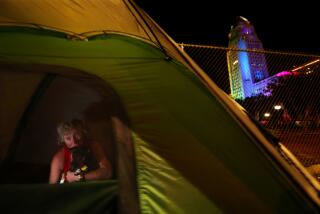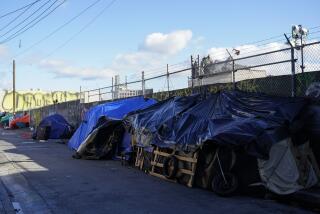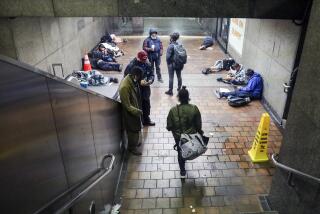Judge pushes for more beds to help resolve housing for Orange County’s homeless

A federal judge Friday set a Sept. 7 deadline for Orange County officials to release housing plans to help a majority of the 2,584 people in the county without shelter.
U.S. District Judge David O. Carter threatened to consider a temporary restraining order preventing cities from enforcing anti-camping ordinances and citing the homeless for sleeping or setting up in public if “there’s no resolution for these men and women.”
Carter said his “breaking point” was the closure of two National Guard armories in Fullerton and Santa Ana on July 15, pushing an additional 200 people onto the streets.
“Folks are coming out of the armories and they need a place to stay,” he said.
“You’ve been wondering a while what the court will do while you’ve been complacent,” he told a room filled with city and county officials, along with the homeless and homeless advocates. He called the group to the courthouse, pressuring them to provide emergency and transitional housing for 1,550 people — equaling 60% of the population lacking shelter.
“We’re going to get down to actual numbers today,” he said. “You can accept them or reject them. Otherwise, litigate it.”
Carter is overseeing a lawsuit filed against Orange County and the cities of Anaheim, Costa Mesa and Orange on behalf of homeless people cleared from a Santa Ana River encampment in January. While allowing for their removal — followed by the eventual clean-up of an illegal tent city at the Santa Ana Civic Center — he has constantly pushed for “humane” evictions and forced officials to do the “hard math” to find places to house the homeless.
Carol Sobel and Brooke Weitzman, attorneys for the homeless, amended their lawsuit last week, writing: “Hundreds of people are, once again, without a place to sleep at night other than on the streets, in the parks and in other public places, where they are experiencing harassment and arrest by law enforcement.”
Carter scheduled Friday’s hearing in response to that update. He told the courtroom: “The good news is certain pockets, communities have really come forward,” tapping on representatives from Anaheim to share their example.
Anaheim Mayor Pro Tem Jose Moreno said his city expects to have an additional 200 beds by year’s end — 60 for emergency intake, with 140 for transitional use — working with a private partner at an undisclosed site.
“Extraordinary times call for extraordinary measures. We try to interrupt the usual because we can no longer tolerate the usual,” Moreno said, alluding to the homelessness crisis.
Others with proposals include Buena Park and Santa Ana — the latter being the O.C. city most affected by transient populations — where officials are talking about opening a facility with 600 to 700 beds, though they hesitate to reveal locations while negotiating with private property owners.
Carter, aided by Susan Price, the county’s homeless czar, divided O.C. into three service planning areas — north, central and south — directing that shelters with 450 beds be built in the north, and 300 beds assigned to each of the other two areas.
Twice, the judge showed a video of his visit to a park where a worker interviewed homeless people who, with nowhere to go, said they resorted to sleeping there but would welcome assistance.
Most of the homeless he has met come from diverse backgrounds, Carter said. They range from Disney workers, UC Irvine students, those who juggle service jobs for the Anaheim Ducks or Los Angeles Angels teams, along with veterans and battered women. Street populations are “open to help,” he said, adding that thinking “that people are not seeking shelter is nonsense.”
Carter said he may support releasing local governments from the lawsuit via settlements, should officials be willing to provide “enough” shelter.
Observers in the courtroom said that the judge probably extended the deadline because each time he pushes, cities make a little more progress, and that he should “shame” them to get to results.
“I’m optimistic, yes, that progress is being made, and we stay true to the belief that we don’t want people shoved off in isolation. We want them to be sheltered where they can access services, “ Sobel said.
Still, she sees one missing component: “To try to get everyone into permanent supportive housing. That’s our ultimate goal.”
Twitter: @newsterrier
More to Read
Start your day right
Sign up for Essential California for news, features and recommendations from the L.A. Times and beyond in your inbox six days a week.
You may occasionally receive promotional content from the Los Angeles Times.







